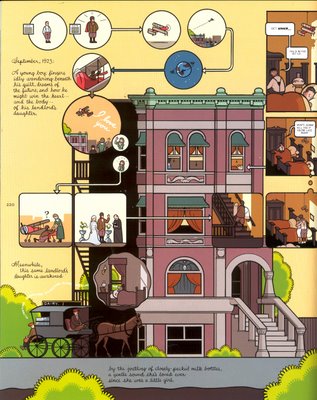The little prince
Published Tuesday, March 28, 2006 by Liliana.Once when I was six years old I saw a magnificent picture in a book, called True Stories from Nature, about the primeval forest. It was a picture of a boa constrictor in the act of swallowing an animal. Here is a copy of the drawing.
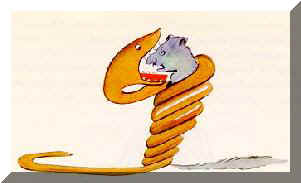
In the book it said: "Boa constrictors swallow their prey whole, without chewing it. After that they are not able to move, and they sleep through the six months that they need for digestion."
I pondered deeply, then, over the adventures of the jungle. And after some work with a colored pencil I succeeded in making my first drawing. My Drawing Number One. It looked like this:

I showed my masterpiece to the grown-ups, and asked them whether the drawing frightened them.
But they answered: "Frighten? Why should any one be frightened by a hat?"
My drawing was not a picture of a hat. It was a picture of a boa constrictor digesting an elephant. But since the grown-ups were not able to understand it, I made another drawing: I drew the inside of the boa constrictor, so that the grown-ups could see it clearly. They always need to have things explained. My Drawing Number Two looked like this:

The grown-ups' response, this time, was to advise me to lay aside my drawings of boa constrictors, whether from the inside or the outside, and devote myself instead to geography, history, arithmetic and grammar. That is why, at the age of six, I gave up what might have been a magnificent career as a painter. I had been disheartened by the failure of my Drawing Number One and my Drawing Number Two. Grown-ups never understand anything by themselves, and it is tiresome for children to be always and forever explaining things to them.
So then I chose another profession, and learned to pilot airplanes. I have flown a little over all parts of the world; and it is true that geography has been very useful to me. At a glance I can distinguish China from Arizona. If one gets lost in the night, such knowledge is valuable.
In the course of this life I have had a great many encounters with a great many people who have been concerned with matters of consequence. I have lived a great deal among grown-ups. I have seen them intimately, close at hand. And that hasn't much improved my opinion of them.
Whenever I met one of them who seemed to me at all clear-sighted, I tried the experiment of showing him my Drawing Number One, which I have always kept. I would try to find out, so, if this was a person of true understanding. But, whoever it was, he, or she, would always say:
"That is a hat."
Then I would never talk to that person about boa constrictors, or primeval forests, or stars. I would bring myself down to his level. I would talk to him about bridge, and golf, and politics, and neckties. And the grown-up would be greatly pleased to have met such a sensible man.
Why is it important if someone eats me?
Published by junetic.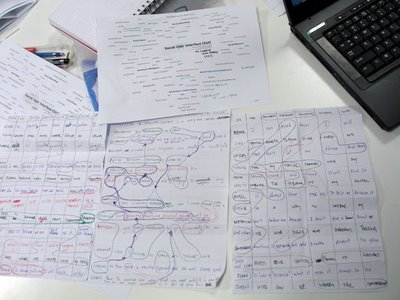
Why is it important if someone eats me?
Broadcasting time won’t pass us because we are part of it.
People use face to face communication for magic.
Visual processing provides glimpses in our heads.
Heads are the purposes of this system.
Purpose frames identity.
How can we learn to communicate playing behavior that frames identity?
Imaginative environments are our spaces that we can share with others.
Solid Affection helps to remember rules about communication.
Where we belong improves our capacity to? Think? Play? Disappear? Act? Love?
Many questions greet neighbors and friends with my questions.
My status tastes better?
Facial quest links to metaphors.
Everyone I own generates narcissism in my dreams, memories and knowledge.
Crafting our memories could make secret languages.
Situations generate our personal metaphors and interfaces.
Group colors go popular.
Crafting blur involves metaphors.
Beautiful memories blur narcissism
Send away secret languages.
Broadcasting special status
White noise flows emotionally.
I should behave malleably.
Special sequences comfort reputation.
Special moments explore and create our identity
Appropriate signs and diagrams help our gestures.
Memories of gestures flow.
Social handicap frees conversations.
Spatial tones play with words.
Handshakes craft comforting memories.(digital)
Conversations are moments of subversion. (conversations as direct tool for subversion through tech)
Free my special narratives.
Signs appropriate subversions of conversation.
Breadcrumbs make spinning diagrams.
Navigating expressions play with sequences of memories.
Sequences of memories improvise our gestures.
Trespassing conversations subvert answers.
Mindscapes involve horror to communicate
Gestures tag memories.
How to combine many questions to express flow?
Slow places and behaviors navigate perception.
Music and voices create words that comfort our identity.
Complements act with caution.
Final Design Schematic
Published by junetic.Genre
Current Song - Artist/Song name
Current Time in Song
User List
Communication Input (text and/or image)
Communication Output (text and/or image)
Next Song Room
Prev Song Room
Auto Next Song from System

1. Start application.
2. Select Genre

1. People come into the station/room when they coincidentally choose listen to the same song.
2. Every time “Send” is pressed, a new "communication space" is created...

1. A random song that no one is currently listening to...from the genre starts to play.
2. User can then surf forward to other songs...andthere may be other listeners..
 1. When the song ends...the system automatically selects another song from the genre...
1. When the song ends...the system automatically selects another song from the genre...2. If the user presses ‘next’ he/she can again navigate to another song "room"...because I dont like the particular song...or people in room
3. Max 10 users per room...
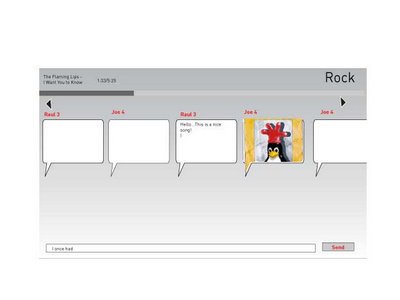
Text input for conversation can become keywords for image input from Google.
Site_Encounter
Published Saturday, March 18, 2006 by junetic.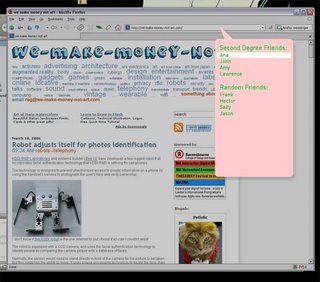
thought allpeers did this...apparently its a bittorent interface integrated with firefox...but would def. be cool though if this im/friendster extension could work with a browser like firefox...socially invading www sites as places for encounter...
Communication Channels
Published by junetic.| Inspired | Wired | Tired |
| physical gestures | game environments | |
| postal service | video-phones | instant messaging |
| face to face | web browser | bulletin boards |
| string paper cup | voip | chat rooms |
| megaphone | sms | mobile voice |
| passing notes | gmail | landline voice |
| carving names under desks | webcams | voicemail |
| whispering | blogs | TV |
| walkie-talkie | | |
| radio | | |
| Phone-tag | | |
| Signs | | |
| | | |
| | | |
| | | |
| | | |
Near Field Social Tech
Published by junetic.http://europe.nokia.com/nokia/0,,73651,00.html
http://www.smallplanet.net/
Wifi Social
https://www.jambo.net
RFID Social
http://www.engadget.com/2005/05/24/rfid-used-clothing-a-social-network-in-your-trousers/
From Wikipedia
Published by Liliana.An operating system is a special computer program that manages the relationship between application software, the wide variety of hardware that makes up a computer system, and the user of the system.
The lowest level of any operating system is its kernel, the first layer of software loaded into computer memory when a system boots, or starts up. The kernel then provides access to various common core services to all other system and application programs. These services include, but are not limited to: disk access, memory management, task scheduling, and access to other hardware devices.
As well as the kernel, an operating system is often distributed with tools for programs to display and manage a graphical user interface, as well as utility programs for tasks such as managing files and configuring the operating system. They are also often distributed with application software that does not relate directly to the operating system's core function, but which the operating system distributor finds advantageous to supply with the operating system. The exact delineation between the operating system and application software is not precise, and is occasionally subject to controversy. For example, one of the key questions in the United States v. Microsoft antitrust trial was whether Microsoft's Internet Explorer web browser was part of its Windows operating system or if it was a separable piece of application software.
Like the term "operating system" itself, the question of what exactly should form the "kernel" is subject to some controversy, with debates over whether things like file systems should be included in the kernel. Various camps advocate microkernels, monolithic kernels, and so on as compromises.
Operating systems are used on many, but by no means all computer systems. The simplest computers, including the smallest embedded systems and many of the first computers did not have operating systems, and relied on the application programmer to manage the minimal hardware themselves, perhaps with the aid of libraries developed for the purpose. Commercially-supplied operating systems are present on virtually all modern devices described as computers, from personal computers to mainframes, as well as mobile computers such as PDAs and mobile phones.



